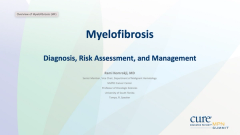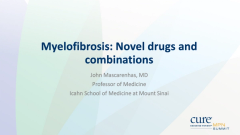
Educated Patient® MPN Summit Polycythemia Vera Panel: May 20, 2023
Watch Dr. Nikolai Podoltsev, Dr. Jerry Spivak and Amy Lane answer questions about polycythemia vera during the CURE® Educated Patient® MPN Summit.
Episodes in this series

This panel was moderated by Brielle Benyon, and included Dr. Nikolai Podoltsev, from Yale School of Medicine, Dr. Jerry Spivak, from Johns Hopkins University School of Medicine, and Amy Lane from the Leukemia and Lymphoma Society.
Benyon: So our first question is going to be for Dr. Podoltsev. Can a patient with pre-existing autoimmune disease be given interferons or are there contraindications for this case?
Podoltsev: So in general, we try to avoid interferons in patients who have autoimmune conditions. So there are always exclusions from the rule and if it is under very well control, you may consider it but you know, there is risk and benefit assessment here. So the risk is, of course, that this condition may become worse. And you know, after all, one of the mechanism of actions for interferons is immune activation of the immune system. And that can certainly lead to worsening of that condition. So to me, it would probably not be the first treatment I am going to offer to a patient who has pre-existing autoimmune condition.
Benyon: Thank you. And for Dr. Spivak, what do we know about the significance of the DNMT3A mutation in polycythemia vera?
Spivak: Um, I do not think it's significant. There are some studies that say if these mutations come up at various times. So, for example, there have been studies and literature claiming that if you get a DMT3A mutation or a TET2 mutation before you get a JAK2 mutation, it changes that phenotype of the disease. And most of those have not proven to have any significance. So I would say, the isolation of that one mutation with a JAK2 mutation, I don't test for it, I don't look for it, it sometimes will come up when we do what we call next generation sequencing, I don't believe in doing PCR, polymerase chain reaction, you can get the whole bone marrow mutation profile with a single tumor blood, and it may come up there. But the thing you have to look for at all times is that these kinds of mutations are clonal. But they're at a very low level. And as long as it's a low level, or it's germline, they don't have any implications we don't treat for.
Benyon: Thank you. And my next question is for Amy. With all the new treatments and advancements and discoveries that are constantly being made in the field of PV, how can patient who was perhaps diagnosed years ago, ensure that they are getting the best and most up to date care?
Lane: That's a great question. Well, first, it's really important that they connect with an organization, if it's an MPN organization or the Leukemia and Lymphoma Society, so they can really be connected and get good, trustworthy information to go by. We have materials that we mail out, and we encourage patients to circle right in the booklets, bring it with them to the doctor, you know, to really get a good understanding. And we update those materials regularly. And we have webinars as well. So the best thing is to just get connected with an organization. We also have a first connection program where we connect you with someone that has the same diagnosis, has had it for a while. So that's another way to not be alone through it and to know the latest advances and blood cancer conferences. There's just so much out there. So I would just say to really, for some folks, step out of their comfort zone and then connect.
Benyon: Fantastic. Thank you so much. My next question, I'll throw this out to anybody who wants to answer. Is it possible for a patient to be diagnosed with ET and have it morph into PV? Or to have PV and ET diagnoses simultaneously?
Spivak: May I? Because I get that question from two sources. I get it one, from the patients and one, from the physicians. Wnd if you look at diagnostic codes, it's a disaster because they'll say the patient has ET and PV. And the problem is the World Health Organization, diagnostic criteria says that PV is erythrocytosis and ET is thrombocytosis. So when a physician in practice is confronted with a patient with both erythrocytosis and thrombocytosis, they assume they have two different diseases. And no. And one way to know that is what's the allele burden, the JAK2 mutation? If it's greater than 50%, it's not ET. And if the red cells are elevated, it's not ET. So this is a real problem in practice. And it's unfortunately, self-inflicted wounds by the physicians allied with the World Health Organization, and I think is really serious. But a fraction of ET patients will morph into PV. Remember, those three stem cells are there, and some of them will morph into primary myelofibrosis. Now, there are people who are, and I don't mean to take up all your time, we're talking about a pre fibrotic myelofibrosis, it's like talking about a pre-pregnant woman who's capable of menstruation. It doesn't mean she's going to get pregnant. And this is a problem. There is no diagnostic test for things like that. But the trick is to follow the allele burn. And note if the hematocrit is going up, that you really don't have ET anymore, because it's PV that's going to cause thrombosis, not ET.
Podoltsev: So I have to agree with Dr. Spivak that. So when red blood cell mass increases, unfortunately we do not have easy means to measure that. So we'll look at hemoglobin and hematocrit. A nd this patient had initially diagnosed with ET, I would manage it like I manage PV. So I would introduce phlebotomy to reduce the risk in these patients.
Benyon: Thank you. Our next question is for Dr. Podoltsev. For patients with PV who are experiencing anemia, and when they're taking (Hydrea [hydroxyurea]), is there a best way to increase iron levels to get them back into the normal range for this patient population?
Podoltsev: So, you know, I mean, the goal of cytoreductive therapy is to normalize hemoglobin and hematocrit. If you develop anemia with diagnosis of PV something is wrong, right? You know, so you have to consider different causes of anemia here, including evolution to myelofibrosis, number one. Number two, this patients have increased risk of bleeding and you need to make sure that they're not over-phlebotomizing themselves by, let's say called GI bleeding. So we usually do not recommend giving iron patients to patients with polycythemia vera therapy because the whole idea of phlebotomy is to make your iron deficient to prevent your body from making red blood cells in the bone marrow where supplies are low and iron is important for making red blood cells. But I do have maybe a handful of patients who develop GI bleeding over the course of their disease. And some of them are older, and they are not good candidates for any interventions. So I developed a sliding scale of very little iron, you know, so perhaps, when the hemoglobin is less than eight, I do one pill a day, then if it is less than minus one every other day. And then above nine, I actually hold off because very quickly, if you start supplying iron, the hemoglobin will go up to the degree where you need to phlebotomize them again. So we have hydroxyurea, if it causes cytopenias, you have to call the medication, decrease the dose, similar to any cytoreductive therapy, you have to modify what you do based on the results. And that's why we monitor, especially at the beginning closely, because we do not really want to overshoot with our cytoreduction.
Benyon: Thank you so much. And my final question is going to go back to Amy. When people are diagnosed with PV or any type of MPN they might not have ever heard of this disease before or know anybody who is facing something similar. How can patients connect with others who are in similar situations as them and why and how is that connection helpful?
Lane: Yep, as I mentioned earlier, we have a first connection program and there's some other organizations that have that as well. So partnering up with someone that in our program, it's folks that want to give back so they've had it for some time. You know, they're managing it well, and they want to be there for a newly diagnosed patient. So I strongly suggest reaching out to us. We can pair you up with someone, you know, female to female, same age and we get as close as we can. And, and these things are really important because it's symptom management and it's tough to live with these symptoms every day and not a lot of people know someone that has an MPN. And we would be able to take care of that, you know, through just a call, you know, and we can take care of finding the match and setting up the calls so you don't feel alone through this. Because it's, you know, it's a chronic disease, and we want them to have as good of quality of life as possible.
For more news on cancer updates, research and education, don’t forget to












